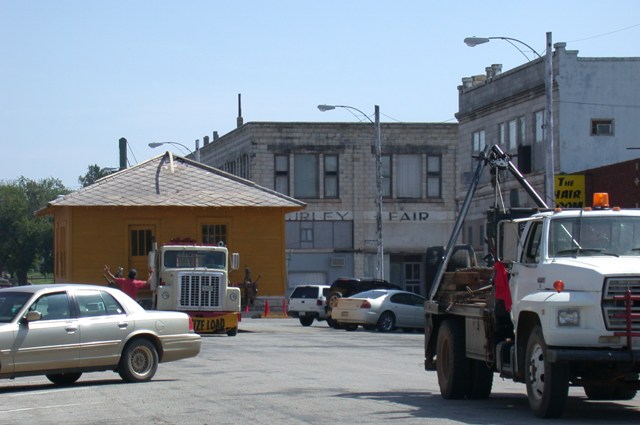|
Moderated by NW Okie! |
Volume 7 , Issue 392005Weekly eZine: (371 subscribers)Subscribe | Unsubscribe Using Desktop... |
Edith (Okla.) Section House Move...

[Photo (on left): The colorful section house as it passes through Downtown Waynoka on Cecil Street on its way to Waynoka Station. Photo 2: The section house as it makes its way through Freedom. Photo 3: Dwayne Hodgson, Freedom, and Dr. Milt Lehr, Alva, watched as the 90-year-old railroad section foreman's house from the Buffalo Northwestern Railroad is readied for the 40-mile move to Waynoka Station. The move was completed in about 3 hours on September 20, 2005.]
"Railroad Section Foreman's House From Edith, OK, Moved To Waynoka Station -- by Dr. Milt Lehr.
During the early settlement of Harper County in northwestern Oklahoma, the people of the area tried in vain for ten years to obtain a railroad for their part of the state. In April, 1916, after losing hope of getting outside interests to build a railroad through Harper County, a group of Buffalo businessmen decided to build a railroad themselves and a charter was granted by the State of Oklahoma for the Buffalo Northwestern Railroad. W.W. Vincent of Freedom and L.E. Walker, a promoter from Dallas, Texas, were leaders in raising money for the construction of the railroad which began on August 27, 1917. The first track laid was a spur connecting with the main line of the Santa Fe Railroad at Waynoka. Santa Fe agreed to furnish rails and other equipment for the railroad and contracted to purchase $300,000 worth of the first mortgage bonds.
After a number of starts and stops, the railroad was completed as far as the town of Brace by October, 1918. J.O. Selman, who lived in southeastern Harper County, advanced $25,000 to help keep the project going.
On September 1, 1919, work was again begun on the line. The old grade was found to be inadequate and most of the rail line had to be rebuilt. Considerable time was necessary to build the big bridge across the Cimarron River from Woods County into Harper County. The railroad crossed the river in February, 1920, and arrived at Buffalo the last of May, 1920.
Because the steam locomotives used by the trains could travel only 15 to 20 miles before they required water, a series of small towns were established. An important requirement of each of these towns was that they had to provide a high quality of water which was stored in wooden water towers. The towns included McKinley, Brace, Fair Valley, Freedom, Edith, Salt Springs, Selman, Lena, and Charleston.
The town of Edith was named for Edith M. Vincent, wife of W.W. Vincent, townsite owner. Roy and Nena Wardrop, pioneer ranchers who live on Highway 64, 2 1/2 miles north of what was once the town of Edith, report that Edith was once had a grocery store, post office, garage, a depot, a wooden water tower, a scale house, seven section houses, a grain elevator, and a stockyard where local ranchers could ship their cattle to various destinations. Trainloads of cattle from Mexico were also shipped to Edith, unloaded and driven to local ranches. A one-room school was once located a half mile from Edith.
The towns listed above continued from 1920 to 1940 until improvements in train engines were made and trains could travel far greater distances before requiring water. This resulted in the demise of many of the smaller towns, including Edith.
The railroad section foreman's house from Edith was donated to the Waynoka Historical Society by Dwayne and Lillian Hodgson. His grandfather had moved the building to a site about 10 miles northwest of Edith and used it for a home. Dwayne and Lillian lived there from 1949-56. It was moved to its present site at Waynoka Station on Tuesday, September 20, 2005. Charles Morton Share Trust, Alva, provided funds to move the railroad house to the historic complex in Waynoka.
The moving of this building will preserve an important part of Woods County history to be enjoyed and appreciated by the many people who come to Waynoka Station, an Official Oklahoma Centennial Project.
Dr. Milt Lehr, a retired professor from NWOSU, and his wife, Becky, spent over two years in restoring the section house, and donated it to the Waynoka Historical Society." -- Sandie, Waynoka Historical Society
| View or Add Comments (0 Comments)
| Receive
updates ( subscribers) |
Unsubscribe
| © . Linda Mcgill Wagner - began © 1999 Contact Me | |
